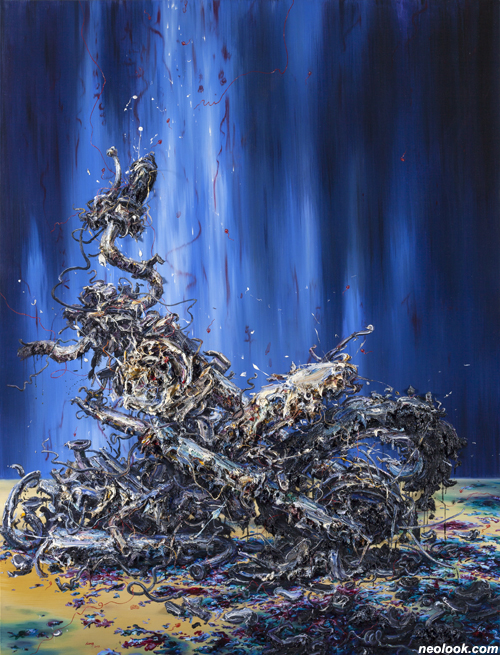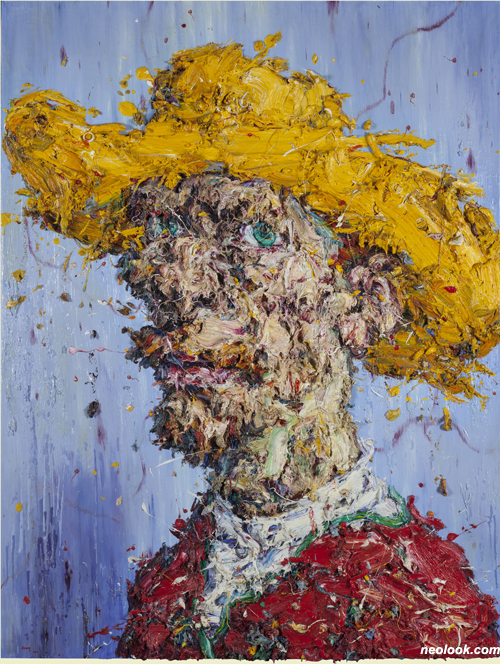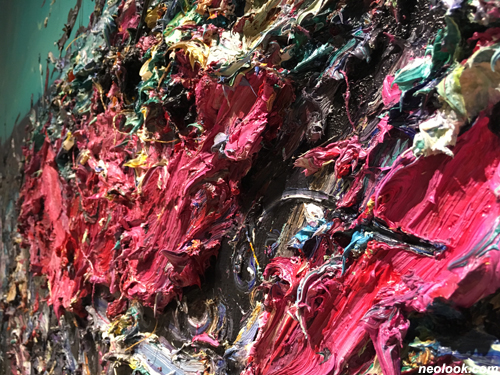- ● homepage
- ● archives
- ● restoration
- ● books
- ● big banners
- ● post board
- ■ neo's search
- ■ about us
- ■ 게재방법 안내
- 개인정보처리방침

- [email protected]
- Tel. 02_335_7922
- Fax. 02_335_7929
- 10:00am~04:30pm
- 월요일~금요일
- 3/3(월) 대체공휴일

熱 情
캉용펑展 / KANGYONGFENG / 康勇峰 / painting 2016_0602 ▶ 2016_0710 / 월,공휴일 휴관

- 캉용펑_Viewing No.114_캔버스에 유채_200×150cm_2015
초대일시 / 2016_0602_목요일_05:00pm
관람시간 / 10:00am~06:00pm / 월,공요일 휴관
갤러리 아트사이드 GALLERY ARTSIDE 서울 종로구 자하문로6길 15(통의동 33번지) Tel. +82.2.725.1020 www.artside.org
열렬 熱烈 : 캉용펑의 회화세계 ● 칸딘스키(Wassily Kandinsky, 1866-1944)에 의하면 회화는 '음악과 같은 에너지를 일으킬 수 있다'. 음악이 듣는 사람으로 하여금 감정을 일으키고 공감을 주는 것과 같이 작품 속 형태와 색채도 보는 이의 속으로 침투하고 반향을 일으켜 깊이 감동시켜야 한다는 것이다. 회화가 지니고 있는 에너지는 우리 눈에 보이고 만질 수 있는 현실 속의 대상과 닮은 경우라 하더라도 그것의 예술다움, 즉 조형적·예술적 가치는 특정한 대상과 닮았다는 점에 있는 것이 아니다. 이는 사물이나 현상을 변형시키고 재구성하는 예술가의 통찰력에 있다고 할 수 있다. 또한 예술가의 영감은 감추어진 자신의 내면세계, 무의식의 세계를 통해 얻은 것으로, 작품에 중요한 요소로 작용하며 독창적인 형식과 주제를 부여하는 것이기도 하다. 작품만이 지니는 형식과 주제는 한 예술가의 에너지와 열정, 가치관 등에 의해 분명하고도 개성적인 조형성을 만들어 낸다. 우리가 작품 속에 예술가들이 표현한 어떤 표징들을 발견할 수 있는 것도 이러한 이유에서 가능한 것이다.

- 캉용펑_Viewing No.88_캔버스에 유채_200×160cm_2011

- 캉용펑_Don't bother who I am No.18_캔버스에 유채_160×120cm_2013
에너지 넘치고 독창적인 회화세계는 중국 작가 캉용펑(康勇峰, Kang Yongfeng, 1979- )의 화면 속에서 찾을 수 있다. 그의 작품에서 가장 먼저 눈에 띄는 것은 형태와 색채, 공간이다. 이후 점차적으로 탄력 있는 질감(te×ture)의 물감 표현이 드러나며, 부드럽고 때로는 매혹적인 색채들과 날카로우면서도 유연한 선들이 모여 유동적이고 암시적인 효과를 품고 있는 듯 보인다. 작품에 나타난 인식 가능한 형태들은 대상을 단순하게 재현한 형태는 아니며, 이 대상에 자신만의 세계를 함축적으로 담아내고 있다. ● 캉용펑은 주로 충돌되고 파괴된 사물과 자신의 작업에 영향을 준 인물 등을 소재로 다루며, 자신의 경험과 이로부터 느낀 감정의 세계를 유화로 표현한다. 그의 대표적인 작품은 「Don't bother who I am」, 「Scenery splinters」, 「Viewing」 등 세 개의 시리즈로 나뉜다.

- 캉용펑_Don't bother who I am No.20_캔버스에 유채_120×120cm_2014

- 캉용펑_Moonlit Night of Spring_캔버스에 유채_240×1000cm_2015~16
「Don't bother who I am」은 고흐(Vincent Willem van Gogh, 1853-1890), 렘브란트(Rembrandt Harmensz van Rijn, 1606-1669) 등 그가 존경하는 예술가들을 소재로 한다. 특히, 고흐는 캉용펑이 학창시절에 그의 자서전을 읽고 그림들을 접하며 이들을 이해하는 동안 가장 큰 영향을 미친 예술가였다. 작품 속 두텁게 쌓아올린 물감의 무게감과 질감은 다양한 색채들이 뒤엉키며 발산하는 에너지와 응축되어 한 예술가의 삶과 열정적인 예술세계를 다시금 돌아보게 만든다. ● 「Scenery splinters」는 만개한 매화의 표정과 힘 있게 뻗어 오르는 역동적인 매화가지를 주된 소재로 하는 작품이다. 그런데 화사한 꽃을 그리고 있음에도 불구하고 차갑고 혹독한 분위기가 느껴지는 것은 무엇 때문인가? 이 풍경은 사실 온전하지 못한 모습이다. 매화가지는 꺾이고 부러진 상처의 흔적을 보이며, 가지 사이 곳곳에 충격으로 인해 균열되고 파괴된 모습이 자리한다. 때로는 피어오르는 화염으로 인한 매캐한 연기와 함께 파편화된 잔해들이 흩날리고 있다. 불안하고도 거친 이 풍경은 작가의 감정이 섞이면서 특유의 강렬하고 두터운 물감의 표현과 자유분방하면서도 힘 있는 붓 터치로 표현적인 요소들이 부각되고 있다. 또한 작가는 활기찬 기법, 즉 현대적인 감각으로 동양의 전통적 소재인 매화를 그리면서 전통적인 가치와 혁신 양쪽 모두에서 작업하는 경향도 보이고 있다.

- 熱情展_갤러리 아트사이드_2016

- 캉용펑_Moonlit Night of Spring_캔버스에 유채_240×1000cm_2015~16_부분
충돌로 인해 파손된 자동차와 오토바이를 소재로 한 「Viewing」 시리즈는 두터운 물감들로 표현된 사실적인 느낌에 압도된다. 작품은 처참하게 부서진 사물들과 그 주변에 흩어진 잔해들로 인해 참혹한 광경을 보여준다. 그러나 난폭하고 거칠기보다는 리듬감 있는 효과를 느끼게 한다. 유화물감으로 가득 찬 캔버스 위에는 오브제들도 발견할 수 있다. 거울 조각으로 인해 반짝임이 있고 끈들은 화면에 운동감을 주어, 사물과 잔해 속에 숨겨진 생명력을 드러낸다. 캉용펑은 색채와 재료의 사용에 있어서 자신이 경험한 것과 느끼는 분위기에 따라 결정하며, 이를 통해 다양한 기법들을 시도하고자 했다. ● 길이 10m에 이르는 「Moonlit night of spring」(2015-16)은 캉용펑의 작품세계를 농축한 대작이다. 자신이 표상하는 물감의 뒤엉킴을 통해 그의 움직임, 즉 행위의 궤적까지도 화면과 밀접하게 결합되고 있다. 작품에는 거칠고 마른 고목들, 제대로 알아 볼 수도 없는 자동차와 오토바이, 정면을 응시하는 사자 한 마리의 모습이 보인다. 이들은 수많은 잔해들과 서로 연결되어 있고 색채와 붓 터치를 통해 자신이 느끼는 감정의 세계를 표현하고 있다. 이 황량한 풍경은 달빛이 비치는 밤과 봄의 계절적인 색채로 서정적이며 몽환적인 느낌을 극대화시키고 있다.

- 캉용펑_Scenery Splinters No. 51_캔버스에 유채_120×200cm_2014
캉용펑은 「Scenery splinters」, 「Viewing」 등 일련의 작품들을 통해 '생명'과 '생명력'을 주제로 다루며, 이를 인식하고 이해하는 자신만의 방식을 보여주고자 했다. 어떠한 형상으로든 나타날 수 있는 생명이라는 것은 그에게 있어 아름다움과 기쁨을 떠올릴 수 있는 동시에, 파괴와 고통을 의미하기도 했다. 이것은 오늘날 우리 사회 모습과 그 속에서의 현상을 대변하는 것으로, 화면 속 소재들은 전부 이러한 의미를 표현하기 위해 작가가 상징적으로 선택한 것이라 할 수 있다. 작가는 부서진 사물들의 하찮은 잔해들까지도 존엄한 존재로 표현하면서 요소요소를 섬세하게 제시한다.

- 캉용펑_Scenery Splinters No.55_캔버스에 유채_80×80cm_2014
이러한 작품의 주제는 그의 캔버스에 두터운 질감의 물감과 강한 색채들로 옮겨지면서 자신만의 개성적인 조형언어가 되었다. 특히 그의 작품에 나타나는 주관적·정신적·표현적인 특징은 역동적이고 힘 있는 붓 터치로부터 발휘된다고 할 수 있다. 이를 통해 구상적이면서도 추상성이 강한 양면성 짙은 화면을 보여주고 있다. 캉용펑에게 추상적인 요소는 모든 사물의 구상적 형태로부터 근원하는 것이다. 작가는 사물을 가까이에서 포착하여 일부분이 나머지 부분과 분리되었을 때 추상적으로 보이는 현상에 주목했다. 그리하여 화면은 추상적으로 보이는 작은 부분들의 조화로운 결합으로 구상적인 형상을 만들어 내는 것이다. ● 캉용펑은 자신이 착안한 기법을 다양한 색채와 밀도로 다양한 크기의 화폭을 사용해 보는 등의 시도를 모두 해본 끝에 자신의 기법이 가진 가능성을 모색하며 꾸준히 실험하고 있다. 그만의 굵직하고 무게감 있는 필력(筆力)과 열렬하고도 뜨거운 '熱情'의 조화 덕분에, 캉용펑은 이번 전시에서 그 어느 때보다도 단단하고 생명력이 풍부한 회화세계를 펼쳐 보일 것이다. ■ 이정진

- 캉용펑_Scenery Splinters No.54_캔버스에 유채_180×100cm_2014
Ardor : Kang Yongfeng's Painting World ● According to Wassily Kandinsky (1866-1944), ‘painting can evoke the energy of music.' He believed that, like music that stirs up a listener's emotion and sympathy, the form and color of an artwork must also enter the viewer's heart, touching them deeply. Although a painting shows an object resembling a real object that we can see and touch, the beauty of a painting ― its formative and artistic value ― is not in that its object is akin to a specific object. This is from the insight of an artist who changes and recomposes an object or phenomenon. The inspiration of an artist is also acquired through their inner and unconscious world, and is an important element of an artwork, giving it a unique form and theme. The form and theme of an artwork build up the artist's distinctive and characteristic formativeness through their energy, passion, and view. It is also because of this that we can find certain signs that an artist has expressed in their pieces ● We can find such an energetic and unique art world in the works of the Chinese artist Kang Yongfeng (1979- ), as well. What are most noticeable in them are their form, color, and space. They soon reveal the expression of colors with an elastic texture, and the soft and fascinating colors and sharp and pliable lines seem to hold a fluid and allusive effect. The forms of the objects we can recognize in them are not simple reproductions, but illustrate Kang's own world implicitly. ● He usually describes crashed and destroyed objects, and figures who have influenced his art. And he expresses his experiences and the emotions that came from these experiences using oil colors. His representative series are "Don't bother who I am," "Scenery splinters," and "Viewing." The series "Don't Bother Who I am" shows artists who he respects, such as Vincent Willem van Gogh (1853-1890) and Rembrandt Harmensz van Rijn (1606-1669). In particular, he was most influenced from van Gogh through his autobiography and pieces. The sense of weight and texture of the thick colors in Kang's pieces is condensed with an energy in which the diverse colors radiate, and make the viewer think of his life and ardent art world. The series "Scenery Splinters" depicts blooming apricot flowers and their strongly stretching branches. However, why do these pieces give off a cold and harsh mood even though they show gorgeous flowers? In fact, these sceneries are not intact; the branches have cut-off or broken traces or cracks from a strong impact. And occasionally, along with an acrid smoke from a soaring flame, flutter remains around them. In these unstable and tough sceneries, Kang's own strong and thick colors stand out, as do the expressive elements from his powerful and freewheeling brushstrokes, as his emotions are mixed with them. In addition, describing Asia's traditional object, the apricot flower, through his vibrant technique, which has a kind of modern sense, Kang also shows a style adopting both tradition and revolution. The series titled "Viewing" depicting broken cars and motorcycles, overwhelms the viewer with a realistic feeling expressed with thick colors; they show terrible scenes with crashed objects and remains scattered around them. However, they make us feel a rhythmic effect rather than a violent and rough effect. We can also find other objets on the canvas, which are full of oil colors too; mirror pieces sparkle and strings disclose a hidden vitality in the objects and remains by giving a sense of motion to the canvas. Kang chooses colors and materials depending on his experience and feeling, and attempts diverse techniques through them. "Moonlit Night of Spring" (2015-16) at 10 m high is Kang's masterpiece in which he concentrated his art world. He combined his motion ― the traces of his action ― closely with the canvas through the tangling of colors, which represents his style. In the work, you can see tough and dried old trees, unrecognizable cars and motorcycles, and a lion looking to the front, which are connected with innumerable remains. Kang expressed his emotions through colors and brushstrokes. This desolate scenery conveys a lyricism through a moonlit night and the color of spring, and maximizes a dreamy feeling. ● In series including "Scenery Splinters" and "Viewing," Kang deals with life and vitality as themes, trying to show his own way of perceiving and understanding them. For him, life that can be described in any form recalls in him beauty and joy, and destruction and pain, simultaneously. This represents our society and the phenomena occurring in it, and thus it can be said that he symbolically selects all of his objects to express such meaning. He offers every object delicately, depicting even trivial remains of broken things as dignified beings. Such themes have become his own formative language, expressed with thick and strong colors on the canvas. In particular, it can be said that subjective and spiritual expressions are created by his dynamic and powerful brushstrokes. Through this, his pieces show representational and yet abstract characteristics, that is, ambivalence. For Kang, abstract elements are rooted in the representational forms of all objects. When a part of an object is divided from its rest, he pays attention to the aspect of being seen abstractly. He then combines small abstract parts harmoniously to create a representational form. ● After he tried diverse attempts with diverse colors and densities, and canvases in various sizes, he is seeking the possibility of his techniques and conducting diverse experiments with them. Thanks to his great and powerful brushstrokes and the harmony of his fervent passion, Kiang is going to display his art world, which is rich in a strong vitality, in this exhibition. ■ Lee Jeongjin
Vol.20160607c | 캉용펑展 / KANGYONGFENG / 康勇峰 / painting
